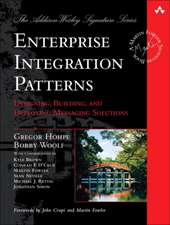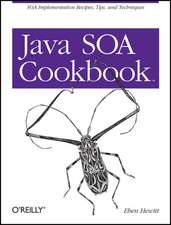Java Concurrency in Practice
Autor Brian Goetz, Joshua Bloch, Joseph Bowbeer, Doug Lea, David Holmes, Tim Peierlsen Limba Engleză Paperback – 31 mai 2006
Preț: 292.13 lei
Preț vechi: 365.16 lei
-20% Nou
55.91€ • 57.62$ • 47.20£
Carte disponibilă
Livrare economică 10-24 februarie
Livrare express 25-31 ianuarie pentru 66.13 lei
Specificații
ISBN-10: 0321349601
Pagini: 403
Ilustrații: illustrations
Dimensiuni: 178 x 234 x 23 mm
Greutate: 0.73 kg
Ediția:1
Editura: Addison-Wesley Professional
Locul publicării:Boston, United States
Public țintă
Academic/professional/technical: Research and professionalTextul de pe ultima copertă
"I was fortunate indeed to have worked with a fantastic team on the design and implementation of the concurrency features added to the Java platform in Java 5.0 and Java 6. Now this same team provides the best explanation yet of these new features, and of concurrency in general. Concurrency is no longer a subject for advanced users only. Every Java developer should read this book."
--Martin Buchholz
JDK Concurrency Czar, Sun Microsystems
"For the past 30 years, computer performance has been driven by Moore's Law; from now on, it will be driven by Amdahl's Law. Writing code that effectively exploits multiple processors can be very challenging. "Java Concurrency in Practice" provides you with the concepts and techniques needed to write safe and scalable Java programs for today's--and tomorrow's--systems."
--Doron Rajwan
Research Scientist, Intel Corp
"This is the book you need if you're writing--or designing, or debugging, or maintaining, or contemplating--multithreaded Java programs. If you've ever had to synchronize a method and you weren't sure why, you owe it to yourself and your users to read this book, cover to cover."
--Ted Neward
Author of "Effective Enterprise Java"
"Brian addresses the fundamental issues and complexities of concurrency with uncommon clarity. This book is a must-read for anyone who uses threads and cares about performance."
--Kirk Pepperdine
CTO, JavaPerformanceTuning.com
"This book covers a very deep and subtle topic in a very clear and concise way, making it the perfect Java Concurrency reference manual. Each page is filled with the problems (and solutions!) that programmers struggle with every day. Effectively exploiting concurrency is becoming more and more important now that Moore's Law is delivering more cores but not faster cores, and this book will show you how to do it."
--Dr. Cliff Click
Senior Software Engineer, Azul Systems
"I have a strong interest in concurrency, and have probably written more thread deadlocks and made more synchronization mistakes than most programmers. Brian's book is the most readable on the topic of threading and concurrency in Java, and deals with this difficult subject with a wonderful hands-on approach. This is a book I am recommending to all my readers of "The Java Specialists' Newsletter," because it is interesting, useful, and relevant to the problems facing Java developers today."
--Dr. Heinz Kabutz
"The Java Specialists' Newsletter"
"I've focused a career on simplifying simple problems, but this book ambitiously and effectively works to simplify a complex but critical subject: concurrency. "Java Concurrency in Practice" is revolutionary in its approach, smooth and easy in style, and timely in its delivery--it's destined to be a very important book."
--Bruce Tate
Author of "Beyond Java"
""Java Concurrency in Practice" is an invaluable compilation of threading know-how for Java developers. I found reading this book intellectually exciting, in part because it is an excellent introduction to Java's concurrency API, but mostly because it captures in a thorough and accessible way expert knowledge on threading not easily found elsewhere."
--Bill Venners
Author of "Inside the Java Virtual Machine"
Threads are a fundamental part of the Java platform. As multicore processors become the norm, using concurrency effectively becomes essential for building high-performance applications. Java SE 5 and 6 are a huge step forward for the development of concurrent applications, with improvements to the Java Virtual Machine to support high-performance, highly scalable concurrent classes and a rich set of new concurrency building blocks. In "Java Concurrency in Practice," the creators of these new facilities explain not only how they work and how to use them, but also the motivation and design patterns behind them.
However, developing, testing, and debugging multithreaded programs can still be very difficult; it is all too easy to create concurrent programs that appear to work, but fail when it matters most: in production, under heavy load. "Java Concurrency in Practice" arms readers with both the theoretical underpinnings and concrete techniques for building reliable, scalable, maintainable concurrent applications. Rather than simply offering an inventory of concurrency APIs and mechanisms, it provides design rules, patterns, and mental models that make it easier to build concurrent programs that are both correct and performant.
This book covers: Basic concepts of concurrency and thread safety Techniques for building and composing thread-safe classes Using the concurrency building blocks in java.util.concurrent Performance optimization dos and don'ts Testing concurrent programs Advanced topics such as atomic variables, nonblocking algorithms, and the Java Memory Model
Descriere
"I was fortunate indeed to have worked with a fantastic team on the design and implementation of the concurrency features added to the Java platform in Java 5.0 and Java 6. Now this same team provides the best explanation yet of these new features, and of concurrency in general. Concurrency is no longer a subject for advanced users only.
Every Java developer should read this book." --Martin Buchholz JDK Concurrency Czar, Sun Microsystems "For the past 30 years, computer performance has been driven by Moore's Law; from now on, it will be driven by Amdahl's Law. Writing code that effectively exploits multiple processors can be very challenging. Java Concurrency in Practice provides you with the concepts and techniques needed to write safe and scalable Java programs for today's--and tomorrow's--systems." --Doron Rajwan Research Scientist, Intel Corp "This is the book you need if you're writing--or designing, or debugging, or maintaining, or contemplating--multithreaded Java programs.
If you've ever had to synchronize a method and you weren't sure why, you owe it to yourself and your users to read this book, cover to cover."--Ted Neward Author of Effective Enterprise Java "Brian addresses the fundamental issues and complexities of concurrency with uncommon clarity. This book is a must-read for anyone who uses threads and cares about performance." --Kirk Pepperdine CTO, JavaPerformanceTuning.com "This book covers a very deep and subtle topic in a very clear and concise way, making it the perfect Java Concurrency reference manual. Each page is filled with the problems (and solutions!) that programmers struggle with every day.
Effectively exploiting concurrency is becoming more and more important now that Moore's Law is delivering more cores but not faster cores, and this book will show you how to do it." --Dr. Cliff Click Senior Software Engineer, Azul Systems "I have a strong interest in concurrency, and have probably written more thread deadlocks and made more synchronization mistakes than most programmers. Brian's book is the most readable on the topic of threading and concurrency in Java, and deals with this difficult subject with a wonderful hands-on approach.
This is a book I am recommending to all my readers of The Java Specialists' Newsletter, because it is interesting, useful, and relevant to the problems facing Java developers today." --Dr. Heinz Kabutz The Java Specialists' Newsletter "I've focused a career on simplifying simple problems, but this book ambitiously and effectively works to simplify a complex but critical subject: concurrency. Java Concurrency in Practice is revolutionary in its approach, smooth and easy in style, and timely in its delivery--it's destined to be a very important book." --Bruce Tate Author of Beyond Java "Java Concurrency in Practice is an invaluable compilation of threading know-how for Java developers.
I found reading this book intellectually exciting, in part because it is an excellent introduction to Java's concurrency API, but mostly because it captures in a thorough and accessible way expert knowledge on threading not easily found elsewhere." --Bill Venners Author of Inside the Java Virtual Machine Threads are a fundamental part of the Java platform. As multicore processors become the norm, using concurrency effectively becomes essential for building high-performance applications. Java SE 5 and 6 are a huge step forward for the development of concurrent applications, with improvements to the Java Virtual Machine to support high-performance, highly scalable concurrent classes and a rich set of new concurrency building blocks.
In Java Concurrency in Practice, the creators of these new facilities explain not only how they work and how to use them, but also the motivation and design patterns behind them. However, developing, testing, and debugging multithreaded programs can still be very difficult; it is all too easy to create concurrent programs that appear to work, but fail when it matters most: in production, under heavy load. Java Concurrency in Practice arms readers with both the theoretical underpinnings and concrete techniques for building reliable, scalable, maintainable concurrent applications.
Rather than simply offering an inventory of concurrency APIs and mechanisms, it provides design rules, patterns, and mental models that make it easier to build concurrent programs that are both correct and performant. This book covers: * Basic concepts of concurrency and thread safety * Techniques for building and composing thread-safe classes * Using the concurrency building blocks in java.util.concurrent * Performance optimization dos and don'ts * Testing concurrent programs * Advanced topics such as atomic variables, nonblocking algorithms, and the Java Memory Model
Notă biografică
Brian Goetz is a software consultant with twenty years industry experience, with over 75 articles on Java development. He is one of the primary members of the Java Community Process JSR 166 Expert Group (Concurrency Utilities), and has served on numerous other JCP Expert Groups.
Tim Peierls is the very model of a modern multiprocessor, with BoxPop.biz, recording arts, and goings on theatrical. He is one of the primary members of the Java Community Process JSR 166 Expert Group (Concurrency Utilities), and has served on numerous other JCP Expert Groups.
Joshua Bloch is a principal engineer at Google and a Jolt Award-winner. He was previously a distinguished engineer at Sun Microsystems and a senior systems designer at Transarc. Josh led the design and implementation of numerous Java platform features, including JDK 5.0 language enhancements and the award-winning Java Collections Framework. He holds a Ph.D. in computer science from Carnegie Mellon University.
Joseph Bowbeer is a software architect at Vizrea Corporation where he specializes in mobile application development for the Java ME platform, but his fascination with concurrent programming began in his days at Apollo Computer. He served on the JCP Expert Group for JSR-166 (Concurrency Utilities).
David Holmes is director of DLTeCH Pty Ltd, located in Brisbane, Australia. He specializes in synchronization and concurrency and was a member of the JSR-166 expert group that developed the new concurrency utilities. He is also a contributor to the update of the Real-Time Specification for Java, and has spent the past few years working on an implementation of that specification.
Doug Lea is one of the foremost experts on object-oriented technology and software reuse. He has been doing collaborative research with Sun Labs for more than five years. Lea is Professor of Computer Science at SUNY Oswego, Co-director of the Software Engineering Lab at the New York Center for Advanced Technology in Computer Applications, and Adjunct Professor of Electrical and Computer Engineering at Syracuse University. In addition, he co-authored the book, Object-Oriented System Development (Addison-Wesley, 1993). He received his B.A., M.A., and Ph.D. from the University of New Hampshire.
Cuprins
Listings xii Preface xvii Chapter 1: Introduction 1
1.1 A (very) brief history of concurrency 1 1.2 Benefits of threads 3 1.3 Risks of threads 5 1.4 Threads are everywhere 9
Part I: Fundamentals 13 Chapter 2: Thread Safety 15
2.1 What is thread safety? 17 2.2 Atomicity 19 2.3 Locking 23 2.4 Guarding state with locks 27 2.5 Liveness and performance 29
Chapter 3: Sharing Objects 33
3.1 Visibility 33 3.2 Publication and escape 39 3.3 Thread confinement 42 3.4 Immutability 46 3.5 Safepublication 49
Chapter 4: Composing Objects 55
4.1 Designing a thread-safe class 55 4.2 Instance confinement 58 4.3 Delegating thread safety 62 4.4 Adding functionality to existing thread-safe classes 71 4.5 Documenting synchronization policies 74
Chapter 5: Building Blocks 79
5.1 Synchronized collections 79 5.2 Concurrent collections 84 5.3 Blocking queues and the producer-consumer pattern 87 5.4 Blocking and interruptible methods 92 5.5 Synchronizers 94 5.6 Building an efficient, scalable result cache 101
Part II: Structuring Concurrent Applications 111 Chapter 6: Task Execution 113
6.1 Executing tasks in threads 113 6.2 The Executor framework 117 6.3 Finding exploitable parallelism 123
Chapter 7: Cancellation and Shutdown 135
7.1 Task cancellation 135 7.2 Stopping a thread-based service 150 7.3 Handling abnormal thread termination 161 7.4 JVM shutdown 164
Chapter 8: Applying Thread Pools 167
8.1 Implicit couplings between tasks and execution policies 167 8.2 Sizing thread pools 170 8.3 Configuring ThreadPoolExecutor 171 8.4 Extending ThreadPoolExecutor 179 8.5 Parallelizing recursive algorithms 181
Chapter 9: GUI Applications 189
9.1 Why are GUIs single-threaded? 189 9.2 Short-running GUI tasks 192 9.3 Long-running GUI tasks 195 9.4 Shared data models 198 9.5 Other forms of single-threaded subsystems 202
Part III: Liveness, Performance, and Testing 203 Chapter 10: Avoiding Liveness Hazards 205
10.1 Deadlock 205 10.2 Avoiding and diagnosing deadlocks 215 10.3 Other liveness hazards 218
Chapter 11: Performance and Scalability 221
11.1 Thinking about performance 221 11.2 Amdahl's law 225 11.3 Costs introduced by threads 229 11.4 Reducing lock contention 232 11.5 Example: Comparing Map performance 242 11.6 Reducing context switch overhead 243
Chapter 12: Testing Concurrent Programs 247
12.1 Testing for correctness 248 12.2 Testing for performance 260 12.3 Avoiding performance testing pitfalls 266 12.4 Complementary testing approaches 270
Part IV: Advanced Topics 275 Chapter 13: Explicit Locks 277
13.1 Lock and ReentrantLock 277 13.2 Performance considerations 282 13.3 Fairness 283 13.4 Choosing between synchronized and ReentrantLock 285 13.5 Read-write locks 286
Chapter 14: Building Custom Synchronizers 291
14.1 Managing state dependence 291 14.2 Using condition queues 298 14.3 Explicit condition objects 306 14.4 Anatomy of a synchronizer 308 14.5 AbstractQueuedSynchronizer 311 14.6 AQS in java.util.concurrent synchronizer classes 314
Chapter15: Atomic Variables and Nonblocking Synchronization 319
15.1 Disadvantages of locking 319 15.2 Hardware support for concurrency 321 15.3 Atomic variable classes 324 15.4 Nonblocking algorithms 329
Chapter 16: The Java Memory Model 337
16.1 What is a memory model, and why would I want one? 337 16.2 Publication 344 16.3 Initialization safety 349
Appendix A: Annotations for Concurrency 353
A.1 Class annotations 353 A.2 Field andmethod annotations 353
Bibliography 355 Index 359













